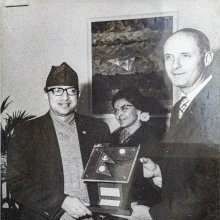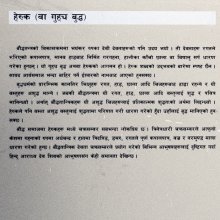Hunda, Huṇḍa, Humda, Humdu, Huṃdā: 16 definitions
Introduction:
Hunda means something in Hinduism, Sanskrit, Jainism, Prakrit, Marathi. If you want to know the exact meaning, history, etymology or English translation of this term then check out the descriptions on this page. Add your comment or reference to a book if you want to contribute to this summary article.
Images (photo gallery)
In Hinduism
Purana and Itihasa (epic history)
Source: archive.org: Puranic Encyclopedia1) Huṇḍa (हुण्ड).—An asura, the son of Vipracitti. (He abducted Aśokasundarī, sister of Subrahmaṇya. (Padma Purāṇa). (See under Aśokasundarī).
2) Huṇḍa (हुण्ड).—An urban region in ancient India. The people of this area were known as Huṇḍas. Īn the great war they fought on the side of the Pāṇḍavas. They took their positions in the Krauñcāruṇa vyūha formed by Nakula and Sahadeva. (Bhīṣma Parva, Chapter 50, Verse 51).
Source: JatLand: List of Mahabharata people and placesHuṇḍa (हुण्ड) is a name mentioned in the Mahābhārata (cf. VI.46.47) and represents one of the many proper names used for people and places. Note: The Mahābhārata (mentioning Huṇḍa) is a Sanskrit epic poem consisting of 100,000 ślokas (metrical verses) and is over 2000 years old.

The Purana (पुराण, purāṇas) refers to Sanskrit literature preserving ancient India’s vast cultural history, including historical legends, religious ceremonies, various arts and sciences. The eighteen mahapuranas total over 400,000 shlokas (metrical couplets) and date to at least several centuries BCE.
In Jainism
General definition (in Jainism)
Source: archive.org: TrisastisalakapurusacaritraHuṇḍa (हुण्ड) refers to a body in which every part is misshapen, and represents the fourth of the six caturasra-susaṃsthana (“symmetrical bodies”), according to chapter 1.2 [ādīśvara-caritra] of Hemacandra’s 11th century Triṣaṣṭiśalākāpuruṣacaritra: an ancient Sanskrit epic poem narrating the history and legends of sixty-three illustrious persons in Jainism.—(cf. Samavāyāṅgasūtra 155, p. 150. Sthānāṅgasūtra 495, pp. 357-8.)

Jainism is an Indian religion of Dharma whose doctrine revolves around harmlessness (ahimsa) towards every living being. The two major branches (Digambara and Svetambara) of Jainism stimulate self-control (or, shramana, ‘self-reliance’) and spiritual development through a path of peace for the soul to progess to the ultimate goal.
Languages of India and abroad
Marathi-English dictionary
Source: DDSA: The Molesworth Marathi and English Dictionaryhuṇḍa (हुंड).—m Besmearing (of a piece of stained or soiled gold) with a preparation of brickdust, salt &c., and heating of it in the fire;--in order to cleanse it. v dē. Also such preparation.
--- OR ---
huṇḍā (हुंडा).—m Money given at marriages by the father of the bride to the bridegroom and his party, instead of the ornaments and clothes usually presented. 2 An ear of the grain jōndhaḷā (sometimes of maize and of gram) plucked before fully ripe, to be parched and eaten. 3 A solid kind of bamboo. 4 A monopoly, a farm, a contract. See detail under huṇḍavā. 5 The cess upon land irrigated by wells or a well; i. e. assessment in gross (as it were by maktā or contract); not by the bigha, but by the reach of the water of the wells or well. Hence vihīrahuṇḍā 6 The pounder or bruising beam of an oilmill. 7 An application (to a gold trinket or to gold) of a mixture in water of brickdust and salt, and a heating of it in the fire. v dē. capakā is a heating (of a trinket &c.) after the application to it of blue stone and some khāra. Hence huṇḍācapakā as a comprehensive or general term for such operations. v dē, lāva.
--- OR ---
huṇḍā (हुंडा).—a Of which the horns are wanting, or crumpled, or turned back;--a horned beast. Hence huṇḍā baila A blockhead or numskull. huṇḍyā kapāḷācā Of a compressed or narrow forehead.
Source: DDSA: The Aryabhusan school dictionary, Marathi-Englishhuṇḍā (हुंडा).—m Money given at marriages by the father of the bride to the bridegroom. An ear of some grain. A kind of bamboos. A monopoly. Assessment in gross.
--- OR ---
huṇḍā (हुंडा).—a Of crumpled horns-a beast.
Marathi is an Indo-European language having over 70 million native speakers people in (predominantly) Maharashtra India. Marathi, like many other Indo-Aryan languages, evolved from early forms of Prakrit, which itself is a subset of Sanskrit, one of the most ancient languages of the world.
Sanskrit dictionary
Source: DDSA: The practical Sanskrit-English dictionaryHuṇḍa (हुण्ड).—
1) A tiger.
2) A ram.
3) A blockhead.
4) A village-hog.
5) A demon.
Derivable forms: huṇḍaḥ (हुण्डः).
Source: Cologne Digital Sanskrit Dictionaries: Shabda-Sagara Sanskrit-English DictionaryHuṇḍa (हुण्ड).—m.
(-ṇḍaḥ) 1. A tiger. 2. A village-hog. 3. A blockhead. 4. An imp, a goblin. 5. A ram. E. huḍi to collect, ac aff.
Source: Cologne Digital Sanskrit Dictionaries: Benfey Sanskrit-English DictionaryHuṇḍa (हुण्ड).—m. 1. A tiger. 2. A ram. 3. A village hog. 4. An imp. 5. A blockhead.
Source: Cologne Digital Sanskrit Dictionaries: Cappeller Sanskrit-English DictionaryHuṇḍa (हुण्ड).—[masculine] the same; [plural] [Name] of a people.
Source: Cologne Digital Sanskrit Dictionaries: Monier-Williams Sanskrit-English Dictionary1) Huṇḍa (हुण्ड):—[from huṇḍ] m. a ram (cf. huḍa), [Kāśī khaṇḍa, from the skanda-purāṇa]
2) [v.s. ...] a tiger, [cf. Lexicographers, esp. such as amarasiṃha, halāyudha, hemacandra, etc.]
3) [v.s. ...] a village hog, [cf. Lexicographers, esp. such as amarasiṃha, halāyudha, hemacandra, etc.]
4) [v.s. ...] a blockhead, [cf. Lexicographers, esp. such as amarasiṃha, halāyudha, hemacandra, etc.]
5) [v.s. ...] a Rākṣasa, [cf. Lexicographers, esp. such as amarasiṃha, halāyudha, hemacandra, etc.]
6) [v.s. ...] ([probably]) an ear (of corn), [Siṃhāsana-dvātriṃśikā or vikramāditya-caritra, jaina recension]
7) [v.s. ...] ([plural]) Name of a people ([varia lectio] pauṇḍra), [Mahābhārata]
8) Huṇḍā (हुण्डा):—[from huṇḍa > huṇḍ] f. crackling (of fire), [Kāśī khaṇḍa, from the skanda-purāṇa [Scholiast or Commentator]]
Source: Cologne Digital Sanskrit Dictionaries: Yates Sanskrit-English DictionaryHuṇḍa (हुण्ड):—(ṇḍaḥ) 1. m. A tiger; village hog; ram; blockhead; a goblin.
Source: DDSA: Paia-sadda-mahannavo; a comprehensive Prakrit Hindi dictionary (S)Huṇḍa (हुण्ड) in the Sanskrit language is related to the Prakrit word: Huṃḍa.
[Sanskrit to German]
Sanskrit, also spelled संस्कृतम् (saṃskṛtam), is an ancient language of India commonly seen as the grandmother of the Indo-European language family (even English!). Closely allied with Prakrit and Pali, Sanskrit is more exhaustive in both grammar and terms and has the most extensive collection of literature in the world, greatly surpassing its sister-languages Greek and Latin.
Prakrit-English dictionary
Source: DDSA: Paia-sadda-mahannavo; a comprehensive Prakrit Hindi dictionaryHuṃḍa (हुंड) in the Prakrit language is related to the Sanskrit word: Huṇḍa.
Prakrit is an ancient language closely associated with both Pali and Sanskrit. Jain literature is often composed in this language or sub-dialects, such as the Agamas and their commentaries which are written in Ardhamagadhi and Maharashtri Prakrit. The earliest extant texts can be dated to as early as the 4th century BCE although core portions might be older.
Kannada-English dictionary
Source: Alar: Kannada-English corpusHuṃḍa (ಹುಂಡ):—
1) [noun] a man lacking normal intelligence or understanding; a slow-witted, stupid fellow.
2) [noun] the quality of being unpleasant or offensive to look at; ugliness.
--- OR ---
Huṃḍā (ಹುಂಡಾ):—[noun] the money, goods or estate that a wife brings to her husband at marriage; dowry.
--- OR ---
Huṃḍu (ಹುಂಡು):—
1) [noun] a small piece taken out from a whole; a fragment.
2) [noun] a small area; a patch.
3) [noun] a drop (of water or any other liquid).
Kannada is a Dravidian language (as opposed to the Indo-European language family) mainly spoken in the southwestern region of India.
Nepali dictionary
Source: unoes: Nepali-English DictionaryHuṃdā (हुंदा):—[=हुँदा] n. pl. of हुँदो [huṃdo]
Nepali is the primary language of the Nepalese people counting almost 20 million native speakers. The country of Nepal is situated in the Himalaya mountain range to the north of India.
See also (Relevant definitions)
Starts with (+7): Humdaguttige, Humdahalata, Humdasamsthana, Humdavali, Humdavani, Humdavanna, Hundabhada, Hundacapaka, Hundada, Hundadanem, Hundadi, Hundaka, Hundaki, Hundana, Hundanavala, Hundanem, Hundanesha, Hundapanda, Hundar, Hundara.
Query error!
Full-text: Humdukoli, Barihumda, Hamdahumda, Husihumda, Pati hunda, Hundapanda, Hundanem, Honda, Hundebandi, Humdasamsthana, Hundekari, Hundacapaka, Sihunda, Vihunda, Caturashra, Gahapati, Shata, Pati.
Relevant text
Search found 13 books and stories containing Hunda, Huṇḍa, Huṇḍā, Humda, Huṃḍa, Hundu, Huṇḍu, Huṃḍā, Humdu, Huṃḍu, Huṃdā, Hundaa; (plurals include: Hundas, Huṇḍas, Huṇḍās, Humdas, Huṃḍas, Hundus, Huṇḍus, Huṃḍās, Humdus, Huṃḍus, Huṃdās, Hundaas). You can also click to the full overview containing English textual excerpts. Below are direct links for the most relevant articles:
List of Mahabharata people and places (by Laxman Burdak)
Padma Purana (by N.A. Deshpande)
Chapter 114 - The Fight between Nahuṣa and Huṇḍa Starts < [Section 2 - Bhūmi-khaṇḍa (section on the earth)]
Chapter 115 - Huṇḍa is Killed in the Battle < [Section 2 - Bhūmi-khaṇḍa (section on the earth)]
Chapter 105 - Nahuṣa is Born < [Section 2 - Bhūmi-khaṇḍa (section on the earth)]
Puranic encyclopaedia (by Vettam Mani)
Studies in the Upapuranas (by R. C. Hazra)
Shiva Purana (by J. L. Shastri)
Chapter 47 - Description of swallowing Śukra < [Section 2.5 - Rudra-saṃhitā (5): Yuddha-khaṇḍa]
Chapter 48 - Swallowing of Śukra < [Section 2.5 - Rudra-saṃhitā (5): Yuddha-khaṇḍa]
Notices of Sanskrit Manuscripts (by Rajendralala Mitra)
Page 384 < [Volume 3 (1874)]

